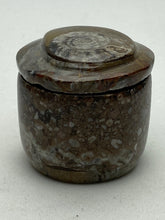Unveiling the Geological Marvel: Tiger's Eye
In the world of minerals and gemstones, few hold the intrigue and visual allure quite like Tiger's Eye. Renowned for its golden-brown hues and unique chatoyant bands, this gemstone really impresses. Beyond its aesthetic appeal, Tiger's Eye offers a fascinating glimpse into the geological processes that shape our planet and the remarkable transformations that occur deep within the Earth's crust.
Tiger's Eye is a member of the quartz family and is a member of the silicate mineral group. Its distinctive appearance is the result of pseudomorphism, a geological phenomenon where one mineral transforms into another while retaining the original crystal structure. In the case of Tiger's Eye, the original mineral is called crocidolite, a form of asbestos composed of fibrous crystals of iron-rich amphibole.
The transformation of crocidolite into Tiger's Eye occurs through a process known as replacement (or substitution). Over millions of years, as crocidolite-bearing rocks undergo metamorphism due to heat, pressure, and chemical alteration, the fibrous crystals of crocidolite are gradually replaced by silica (quartz) through a process called silicification. This replacement process preserves the fibrous structure of the crocidolite while imparting the characteristic golden-brown color of Tiger's Eye.
What truly sets Tiger's Eye apart is its chatoyancy, also known as the "cat's eye effect." This optical phenomenon is caused by the parallel arrangement of fibrous crystals within the mineral, which reflect light in such a way that a luminous band appears to move across the surface of the stone when it is viewed from different angles. This mesmerizing play of light adds depth and dimension to Tiger's Eye, giving it a dynamic and captivating appearance.
Tiger's Eye is primarily found in metamorphic rock formations, particularly those subjected to regional metamorphism, where intense heat and pressure alter the mineral composition of rocks over large geographic areas. This geological environment is conducive to the formation of Tiger's Eye, as it provides the necessary conditions for the transformation of crocidolite into quartz while preserving the fibrous structure that gives Tiger's Eye its unique appearance.
While Tiger's Eye is best known for its golden-brown coloration, it can also exhibit variations such as red, blue, and green, depending on the presence of other minerals and impurities during its formation. For example, the presence of iron oxides may impart a reddish-brown hue known as "red Tiger's Eye," while the inclusion of hawk's eye, another variety of quartz, may result in a bluish-gray coloration.
In addition to its use as a gemstone in jewelry and ornamental objects, Tiger's Eye also has practical applications in various industries. Its durability, hardness, and attractive appearance make it a popular choice for countertops, flooring tiles, and decorative stone veneers in architectural and interior design projects. Additionally, its chatoyant properties have inspired the creation of decorative objects such as rock candles, beads, cabochons, and bottle stoppers which showcase its mesmerizing optical effects.
In conclusion, Tiger's Eye is a geological marvel that exemplifies the intricate processes of mineral formation and transformation within the Earth's crust. From its origins as crocidolite-bearing rocks to its metamorphic journey culminating in the creation of Tiger's Eye, this mineral captivates with its beauty and reveals the fascinating interplay of geological forces that shape our world. As we marvel at its golden hues and shimmering bands, let us appreciate Tiger's Eye not only for its aesthetic appeal but also for the geological story it tells about our planet's rich and dynamic history.
Tiger's Eye is a member of the quartz family and is a member of the silicate mineral group. Its distinctive appearance is the result of pseudomorphism, a geological phenomenon where one mineral transforms into another while retaining the original crystal structure. In the case of Tiger's Eye, the original mineral is called crocidolite, a form of asbestos composed of fibrous crystals of iron-rich amphibole.
The transformation of crocidolite into Tiger's Eye occurs through a process known as replacement (or substitution). Over millions of years, as crocidolite-bearing rocks undergo metamorphism due to heat, pressure, and chemical alteration, the fibrous crystals of crocidolite are gradually replaced by silica (quartz) through a process called silicification. This replacement process preserves the fibrous structure of the crocidolite while imparting the characteristic golden-brown color of Tiger's Eye.
What truly sets Tiger's Eye apart is its chatoyancy, also known as the "cat's eye effect." This optical phenomenon is caused by the parallel arrangement of fibrous crystals within the mineral, which reflect light in such a way that a luminous band appears to move across the surface of the stone when it is viewed from different angles. This mesmerizing play of light adds depth and dimension to Tiger's Eye, giving it a dynamic and captivating appearance.
Tiger's Eye is primarily found in metamorphic rock formations, particularly those subjected to regional metamorphism, where intense heat and pressure alter the mineral composition of rocks over large geographic areas. This geological environment is conducive to the formation of Tiger's Eye, as it provides the necessary conditions for the transformation of crocidolite into quartz while preserving the fibrous structure that gives Tiger's Eye its unique appearance.
While Tiger's Eye is best known for its golden-brown coloration, it can also exhibit variations such as red, blue, and green, depending on the presence of other minerals and impurities during its formation. For example, the presence of iron oxides may impart a reddish-brown hue known as "red Tiger's Eye," while the inclusion of hawk's eye, another variety of quartz, may result in a bluish-gray coloration.
In addition to its use as a gemstone in jewelry and ornamental objects, Tiger's Eye also has practical applications in various industries. Its durability, hardness, and attractive appearance make it a popular choice for countertops, flooring tiles, and decorative stone veneers in architectural and interior design projects. Additionally, its chatoyant properties have inspired the creation of decorative objects such as rock candles, beads, cabochons, and bottle stoppers which showcase its mesmerizing optical effects.
In conclusion, Tiger's Eye is a geological marvel that exemplifies the intricate processes of mineral formation and transformation within the Earth's crust. From its origins as crocidolite-bearing rocks to its metamorphic journey culminating in the creation of Tiger's Eye, this mineral captivates with its beauty and reveals the fascinating interplay of geological forces that shape our world. As we marvel at its golden hues and shimmering bands, let us appreciate Tiger's Eye not only for its aesthetic appeal but also for the geological story it tells about our planet's rich and dynamic history.






